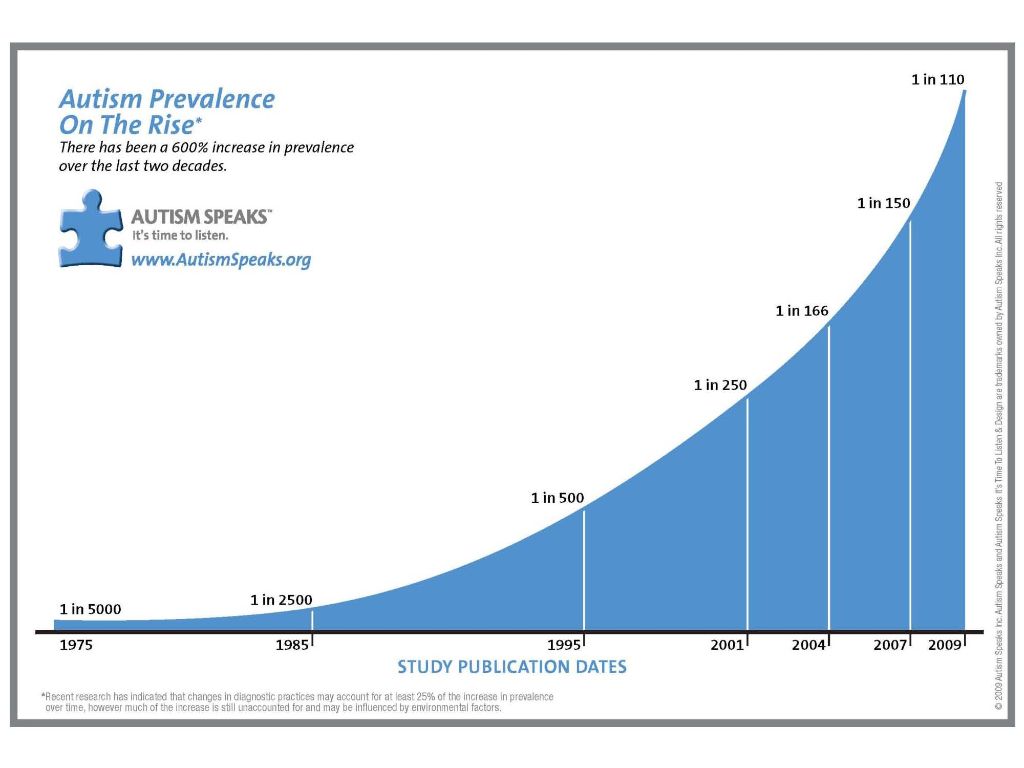On two occasions in the past week or so, I have been involved in discussions on the increasing prevalence of autism. In the more recent of these, the individual with whom I was talking expressed the concern that the recent DSM enlargement of autism disorder to autism spectrum disorder might be an APA-pharma designed artifact to draw attention away from the steady increase in the incidence of autism in recent decades.
Of course, I have no direct knowledge of any such conspiracy, but given the history of the last few decades, I had to concede that the notion was within the realm of possibility.
And then on Sunday (June 9) I came across an article on Mad in America. It’s called See No Evil, Hear No Evil, and was written by Kelly Brogan, MD. Dr. Brogan is a member of the American Board of Integrated Holistic Medicine, and her article is forthright and outspoken.
Dr. Brogan points out that the incidence of autism in 1978 was 1 in 10,000, and is now 1 in 50.
This increase seems almost unbelievable, so I did some checking. Here’s what I found.
Autism Speaks is an organization dedicated to funding research into the causes, prevention, treatments, and cure for autism. They confirm that autism has increased from 1 in 5000 (in 1975) to 1 in 110 (in 2009). (1 in 110 is about 45 in 5000).
These figures are generally consistent with the prevalence numbers from DSM-III and DSM-IV, and from the CDC. Autism Speak’s graph stops at 2009, but the CDC’s figure for 2013 is 1 in 50. One in fifty is equivalent to 100 in 5000. So the reported prevalence has risen from 1 case in 5000 to 100 cases in 5000 in 38 years.
But these figures can’t be taken at face value. The APA’s definition of autism consists entirely of subjectively assessed behaviors (e.g. “lack of social or emotional reciprocity;” “failure to develop peer relationships appropriate to developmental level;” etc…) Because of this definitional vagueness and subjectivity, a measure of discrepancy is to be expected in prevalence estimates across time and from place to place.
An additional complication arises from the fact that the APA’s definition of autism changed considerably from DSM III to IV, and has changed again with the publication of DSM-5.
On the other hand, autism is not a trivial matter, and even allowing for a generous measure of diagnostic imprecision and expansion of the diagnostic criteria to include milder presentations, the idea that more than 90% of cases were simply being missed as recently ago as 1975 is a bit of a stretch. It’s not as if the condition is particularly latent.
Dr. Brogan’s article is strongly worded but nevertheless interesting and worth sharing.
I’m sure we all remember the APA’s inexplicable rush to publish the DSM-5. Was this motivated, as Dr. Brogan suggests, by a pharma-APA conspiracy to expand the concept of autism as a way to obscure an alarming increase in the prevalence of autism?
I don’t know. Dr. Brogan has strong views. She describes DSM-5 as:
“The culminating shame of a profession marked by hack-science, placebo-driven assertions of medication efficacy, manipulation of data and a total absence of objective diagnostic markers.”
And on psychiatric “diagnoses” generally:
“So, at once, we continue to pathologize normative human experience to better sanction mass prescribing to a populace convinced they need these magic pills, but we stop the hemorrhaging on the pediatric statistics that directly implicate the medical-industrial complex and the consequences of reckless obstetrical and pediatric interventions.”
Dr. Brogan, if I understand her article correctly, seems to attribute the increase in autism prevalence to a wide range of environmental factors, including pesticides, processed food, plastic diapers, vaccines, “endocrine disruptors,” etc…
I don’t know much about these matters, but the increase in prevalence estimates warrants some consideration.
